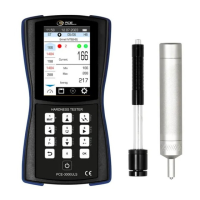The universal probe comes standard
with the hardness tester.
Used for the main number of
measurement tasks
The probe with increased impact
energy (relative to probe "D")
For coarse grained materials up to 450
HB with high surface roughness.
Probe with reduced (to probe "D")
impact energy and diamond indenter
For testing very hard materials
up to 72 HRC
The main type of ultrasonic probe for
solving most hardness measurement
tasks. 5kg/11lb. load is to be applied
for measurement (automatically
controled by the probe). Average
surface cleanliness requirements.
- Heat-treated and cemented parts, for
example, shafts, turbines, gears, teeth,
welds, heat affected zones.
- Measuring in grooves, on teeth, in
grooves, on radius surfaces.
- Measurement on the blades, on the
internal surface of the pipes, openings.
The reduced load probe is designed to
measure the hardness of material with
increased requirements to the print
size (polished surfaces), to the
hardness measure of surface hardened
layers. 1 kg / 2.2 lb. load is to be
applied for measurement
(automatically controlled by the
probe). More sensible to the surface
cleanliness
- Control of the hardness of galvanic
coatings: chrome, copper, tin, nickel, zinc
- Nitrided and cemented surface layers of
molds, stamps, stamps, thin-walled parts.
- Bearings, lateral surfaces of saws teeth.
- Measurement of hardness of hardening
coatings.
- Measurement on the blades, on the inner
surface of the pipes, inside the holes.
Control of the products hardness with
a rough surface up to Ra5. 10 kg /
22 lb. load is to be applied for
measurement (set automatically by the
probe). Low requirements for surface
cleanliness.
- Heat-treated and cemented details.
- Measuring in grooves, on teeth, on
radius surfaces.
- Measurement on the blades, on the
internal surface of the pipes, openings.
Measurements in hard-to-reach places
- on products with teeth, grooves, notches
Measurements in other hard-to-reach
places
in the middle of containers and pipes
from 80 mm / 3.2"
The average conditional diameters of the impressions (mm) created on the surface of
the product when measuring different hardness (for carbon structural steels) are shown in

